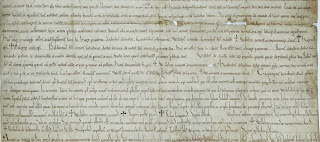Hello and happy fourth of July! Our Summer Scholars program is halfway done, and Dyllan and I have completed four weeks of work. We have learned a lot more about this cartulary. Originally the text began with a set of folios that had a copy of the abbey’s foundation pancarte (more on that below). In the thirteenth century an extra set of four folios were added to the cartulary; they have the text of three charters granted by kings of France. Four folios are also missing – the original folios were numbered, with the copy of the foundation charter beginning on folio 1 recto. Folios 3 – 6 are not in the cartulary. They were apparently removed sometime before the 20th century, but it is unclear when or why this was done.
From folio 7 recto onward there are three distinct scribal hands that we have worked with. There are three examples below:
- The first example shows the handwriting from folio 1 recto to folio 8 verso.
- The second shows the handwriting from folio 9 recto to folio 16 verso. This section has very formulaic charters, and the handwriting gets sloppier and sloppier as the section goes on – we think that our scribe was getting bored with writing the same thing over and over!
- The third handwriting begins on folio 17 recto and continues through at least the next 40 folios – we have not looked past that yet.
 |
| Examples of three different scribal hands from the cartulary. Click to enlarge. |
We also turned our attention to the Saint-Amand pancarte. A pancarte is similar to a cartulary in that it is a copy of many documents collected together, but instead of collected into book form, the pancarte is a single sheet of parchment, with text front and back. Saint-Amand’s pancarte was probably written in 1071; the longest document is a charter of King William of England (this would be William the Conqueror) of grants and guarantees made at the dedication of the church in 1071. This tells us the likely date when the building of the abbey was completed. There would have been a grand ceremony marking the consecration of the church for religious use, and it appears that the nuns took this opportunity to create a pancarte of the early donations made to the house.
 |
| A section of the pancarte written in 1071. Click to enlarge. |
The pancarte document included our first anathema clause. Anathema clauses were included in many medieval charters – they were warnings of what would happen to anyone who tried to break the agreement recorded in the document, or who tried to take goods from the monastic community. This one was issued by John, Archbishop of Rouen from 1067 – 1079, and brother of Abbess Emma. It runs as follows:
“I John, closely connected to the Holy Roman Church, affirm with the sign of the cross + of the Lord by my own hand this charter. If any unjustly wish to destroy this he will be ruined and condemned and excommunicated and cursed with the treacherous Judas, with Herod and Annas and Caiaphas, with all these who were assigned into the fire. Let it be, let it be, let it be.”
Annas and Caiaphas were priests who condemned Christ and handed him over to Pontius Pilate for crucifixion, so this is a pretty serious condemnation!
We are continuing to work on the cartulary, and beginning to map the lands of the nunnery. Our next update should include some maps in a few weeks.
